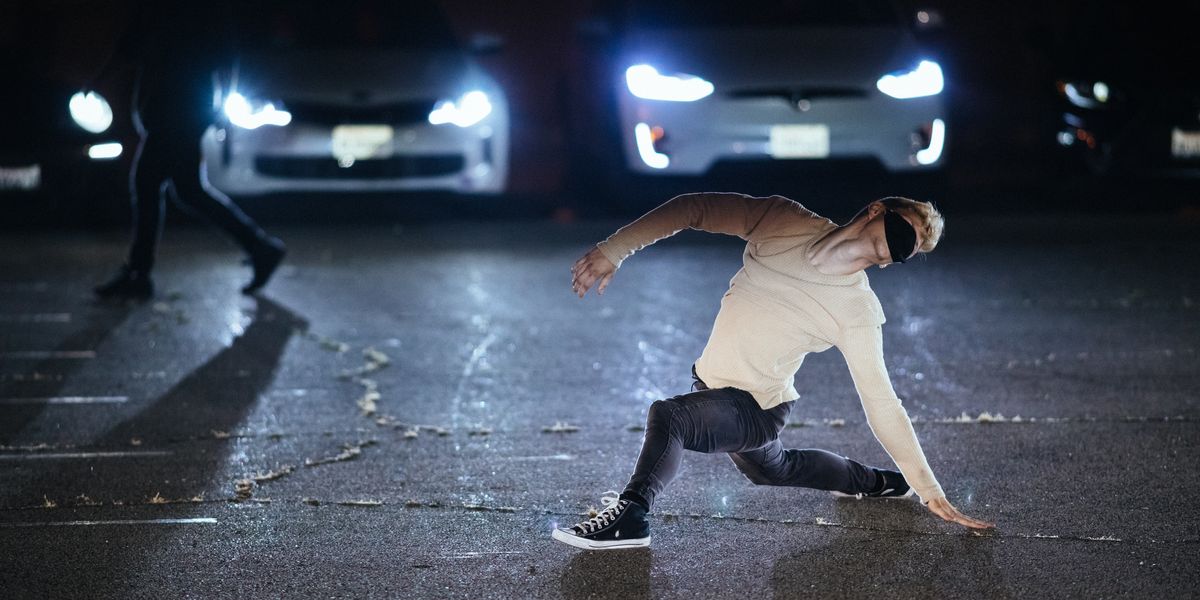Jacob Jonas Has Figured Out the Impossible: How to Safely Put on a Live Dance Performance
On Saturday night, about 35 cars converged at the Santa Monica Airport parking lot. Inside each vehicle, the passengers had 12 pages of instructions: Arrive exactly at 7:50 pm; stay inside your car with the windows rolled up; when you see a flashing light, turn on your headlights; wear a mask.
They had come to see PARKED, an invitation-only, drive-in dance performance put on by Jacob Jonas The Company.

While artists in Seattle had staged a series of scavenger-hunt-style pop-up solos last month, this may be the first socially distant hour-long show presented during the pandemic.
Jonas
had first started brainstorming the event in April, when some doctor friends told him they predicted that nobody would be gathering in a public setting for 12 to 18 months. “I started to get antsy,” says Jonas. He and four other dancers in his apartment complex had been training daily in empty parking garages nearby. But Jonas wanted to be in a creative process again, and he wanted to figure out how to perform in a safe way.
Given his background as a street performer on the Venice Beach boardwalk and Santa Monica promenade, Jonas was in a unique position as a dance company director: He knows how to work safely on concrete, and how to build audiences in a non-traditional setting.
He came up with the idea of setting up cars in a 100-foot circumference circle, using their headlights to illuminate the “stage.”
Within two hours of telling his dancers about his plan, all 16 said yes.
They rehearsed one-on-one while staying six feet apart in abandoned parking garages, keeping outdoors where the virus doesn’t spread as easily. Jonas made two to three solos on each dancer, as well as some simple ensemble movement for along the edges of the circle, like running or holding a position. He also choreographed a finale where the entire cast danced completely in unison—at a safe distance.

Before the show, Jonas required all his dancers to get tested for COVID-19. “Going through the testing site, we learned a lot about how they organize the safety of individuals getting tested, like keeping your windows rolled up and always wearing a mask,” says Jonas. He and his team also researched safety regulations put out by the CDC and the City of Los Angeles.
More than 300 people entered a lottery to get a spot to watch the show. Each car was allowed to bring as many people as could fit in the vehicle, and was asked to give a suggested $100 donation.
The performance ended up raising $4,000. “It felt very special to be able to pay my dancers during this time,” says Jonas.
He also found it inspirational—and emotional—to be able to share art with a live audience. “So many people were saying this was the first time they went out in two months,” says Jonas. “They said it felt so nice to get dressed and show up to something. And just psychologically, to be connected, to be sharing art.”
At the end, as the dancers bowed, all the cars started flashing their lights and honking. “It felt very historic, very raw,” says Jonas.
Although the company was unable to get official permission to put on Saturday’s event due to insurance considerations, and they had to “take a Banksy approach,” says Jonas, he hopes that his footage and testimonials can convince city governments that his model is safe.
After all, the idea was to create a format that other companies could replicate. Jonas encourages anyone interested in learning about the logistics and safety protocols of how to put on a similar event to reach out to him. “I would love to share how to do it with other artists so they can bring dance to their communities, too.”





